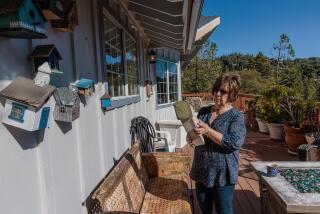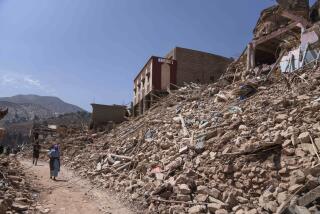Used-Brick Market Bullish as Whittier Prepares to Rebuild
The tearing down in Whittier is largely completed and, for the most part, the rebuilding has yet to begin.
“Right now, we’re still in a period where people are sitting back and waiting--waiting for funding, waiting to see what will happen,” said Richard Hubinger, the city’s director of building and safety, the other day.
If you drive through the residential neighborhoods of Whittier--the town hardest hit by the Oct. 1 earthquake--the first thing you notice is all the little piles of used brick on the sidewalks and curbs.
Most of them came from chimneys that cracked and in some cases crumbled, when the 6.1-magnitude earthquake--and its aftershocks, measuring up to 5.5 on the Richter scale--rattled through the city, causing damage estimated in the tens of millions of dollars.
Downtown, where large portions of several business blocks were damaged beyond repair, the piles are larger but tidier, with trained crews stacking the bricks on pallets for subsequent re-use in someone’s patio or swimming-pool deck.
Whittier is becoming the used-brick capital of the West. Used bricks--which retail for about 60 cents apiece, about a third more than new bricks--are “always in demand,” according to building materials dealers.
Posed Safety Hazard
The demolition work in the community of 70,000 has moved rapidly because the cracked chimneys and crumbling old business buildings posed a safety hazard.
Hubinger said his men, with the help of inspectors from other cities including Los Angeles and West Covina, have had to post more than 450 structures in the city as unsafe. That means that the occupants have had to move out until the hazard is corrected.
In some cases, the hazard has been corrected by the removal of a teetering chimney. In some cases, major structural repairs are required. In others, especially those involving old buildings constructed of unreinforced masonry, the entire building has had to be leveled and hauled away.
Like a lot of his neighbors, Jim Avera, 64, did the necessary demolition work himself, tearing down the crumbling masonry from the cracked fireplace at his home on Beverly Boulevard.
“Cheap mortar,” Avera muttered to himself as he carted the debris to the curb in an old wheelbarrow. “No wonder the damned thing cracked.”
Avera is one of scores of Whittier residents who have applied for federal grants and loans to rebuild damaged structures. Federal guidelines allow a grant of up to $5,000 to help make a home habitable after a disaster.
Contractors All Busy
But Avera said he hasn’t received any money yet, “and even if I had, you can’t get a contractor now, they’re all too busy.”
Trevor Birkholz, a 29-year-old student, can vouch for that. He’s been spending his every spare minute doing demolition work at private homes in Whittier for a La Habra-based contractor.
“All I’ve been doing is tearing down chimneys,” Birkholz said as he lugged the remains of another out to his truck. “No one’s putting anything back up, yet.
“We’re backlogged . . . and people who drive by keep stopping to ask if I can help them with theirs.”
To assist residents, the city has made available a list of more than 200 Southland contractors--without recommending any of them--who may be able to help with repairs or demolition. Several contractors contacted said they are busy and it may be days--even weeks or months--before they can take care of everyone in the stricken community.
Several blocks up from where Birkholz was working on Floral Drive, Martin Farmer, 21, was busy with a demolition and reconstruction crew at the corner of Beverly and Friends Avenue. Farmer and his co-workers are in the process of shoring up four houses at or near the intersection.
Homes Severely Damaged
One of them, a substantial, two-story, Spanish-style home, suffered split walls, shattered roof tiles and such severe cracking where the house and foundations meet that all the lower walls will require re-stuccoing.
Across the street, big posts have been hammered into place to replace porch columns that fell or inclined dangerously during the quake.
Around the corner, a small wood-frame home slid 18 inches off its foundation.
“I’m not sure what they’ll do with that one,” Farmer said. “I guess they’ll figure out some way to lift it back where it was.”
Downtown, along the main business thoroughfare, Greenleaf Avenue, bulldozers and big dump trucks were finishing up their work last week, scraping up the remains of about a dozen old masonry buildings that crumbled dangerously during the earthquake. Many of the displaced businesses currently are operating out of mobile structures parked in streets and parking lots.
“We’ve had a lot of work to do,” said Denny Swain, 52, superintendent for one of the big demolition contractors working at the site. “I didn’t realize how bad it was until we got here.”
More to Read
Sign up for Essential California
The most important California stories and recommendations in your inbox every morning.
You may occasionally receive promotional content from the Los Angeles Times.










